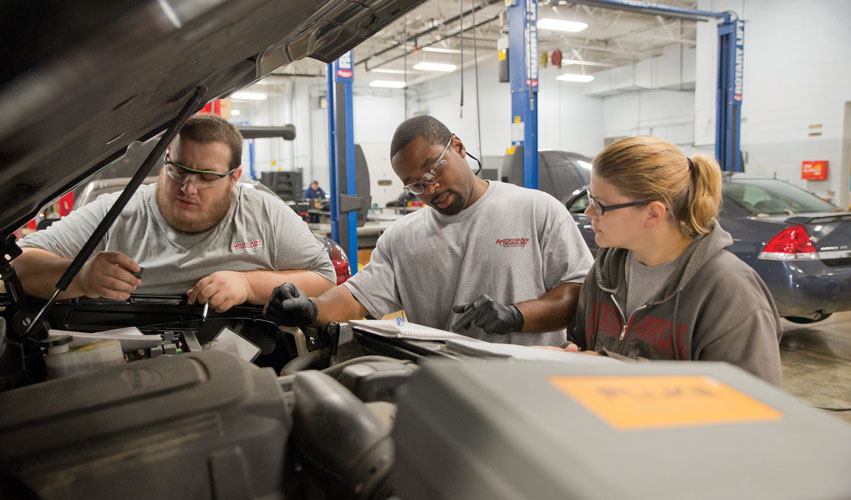
We can close the skills gap by aligning higher education and the workforce system.
Illinois Central College trustees recently heard the compelling story of a young man’s journey through higher education. Following high school, Matt enrolled at ICC, but soon “stopped out.” As he matured, he discovered that he did not have the credentials for a family-sustaining wage. Matt returned to ICC and enrolled in mechatronics and electronics, then acquired an internship at NASA. He completed an associate’s degree, became a student worker for the electronics lab, and concurrently began work on a bachelor’s degree from Southern Illinois University through weekend classes at ICC. Recently, Matt interviewed for a job at the Los Alamos National Lab.
Matt’s pathway through education provides a glimpse of how students are (or are not) accessing higher education. Today, delayed entry like Matt’s—along with high unemployment rates and increasing poverty—challenge our ability to create a strong local workforce. And today, if you are born poor, you have never been more likely to die poor than at any point in our history.
Breaking the Cycle
A post-secondary degree with labor market value breaks this cycle of poverty. But current young adult behavior patterns have had serious impacts on the region’s economic base.
According to the Georgetown University Center on Education and the Workforce, 99 percent of the 11.6 million jobs created between January 2010 and January 2016 required at least some post-secondary education. Clearly, a high school diploma is no longer enough to open the doors to family-sustaining job opportunities. The Georgetown Center reports that young adults, particularly males and African-Americans, experienced declining employment rates. In fact, the employment rate for young adults, ages 21 to 25, eroded by 12 percent between 2000 and 2012, from 84 percent to 72 percent. These young people were more likely to be employed in low wage, part-time work. Ironically, at the same time, businesses are finding it increasingly difficult to hire qualified employees.
In our region, the number of unemployed and underemployed adults is growing, while the simultaneous lack of qualified workers to fill open positions has created a skills gap. While 51 percent of our region’s adults have a high school diploma and/or some college credits, they often lack credentials for skilled jobs. This skills gap leads to a failure to find well-paying jobs, which, in turn, increases poverty levels.
The Human Capital Supply Pipeline
One way to close the gap is by creating a confluence among businesses, the workforce and community colleges. Currently, educational institutions value choice above market need. Students come to college unaware of career opportunities available to them, so they choose from majors and programs uninformed of the market factors affecting their future employability. Meanwhile, business and industry seek increasingly specific skills. Without direct linkages to higher education, these employers must choose from a limited, credentialed talent pool that often does not have the right skills. This is akin to a manufacturer creating product not based on a strategic supply chain of materials, but on whatever supplies happen to be available. Obviously the potential for satisfying market needs is severely limited under this approach!
We can fix this human capital supply pipeline. First, we must provide students increased opportunities to learn what careers are available to them and create the capacity to make informed choices on their programs of study. At the same time, colleges must listen to and partner with business and industry to ensure that programming provides skills which support the community’s economic engines. ICC is increasing its partnerships with employers to provide hands-on, real work experiences for students, such as internships and apprenticeships.
Together, we can integrate our workforce and college systems to increase the number of graduates with credentials who meet our regional workforce needs and can then move quickly into the waiting job opportunities. The community benefits as local young adults enter and grow the workforce.
Creating the Confluence
Three key initiatives ICC is developing to create this confluence are: early college, internships/apprenticeships, and ladders or pathways for careers. Early college offers high school students the opportunity to experience and succeed in college work. This “jumpstart” has been related to increased college persistence and completion. The benefits of internships and apprenticeships are too numerous to list, but they allow students to get a feel for careers and provide employers the much sought-after, experienced job candidate.
Career ladders and pathways help students start out in basic skillsets tied to specific jobs, and then build from certificates to associate’s degrees to bachelor’s and beyond. These ladders provide career development exit and entrance ramps to increasing levels of skill and employability. This is especially important for adults who need to work full time and cannot afford to wait two years for a financial payoff to their education. Career ladders allow students like Matt to “get their feet wet,” and then see all the grand possibilities ahead.
Higher education and workforce systems need to align if we want to stem the regional tide of increasing poverty and workforce gaps. ICC is a willing partner in determining the region’s current workforce needs and using that data, along with workforce-based experiences, to guide more students toward informed career decisions.
As we work in new and expanded ways with businesses and regional industries, we can create a “win-win” for everyone. Students will be more experienced and credentialed, business will have access to a highly-qualified workforce, and the poverty and workforce gaps will narrow. While change is difficult, the idea of “confluence”—working together to improve our workforce and reverse the educational access trends among young adults—has been met with support and enthusiasm. This confluence will not only improve the lives of these adults, but also their families, the workforce and our region’s economic viability. iBi
Dr. Sheila Quirk-Bailey is president of Illinois Central College.

